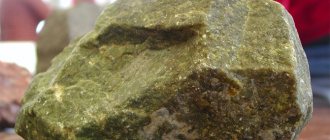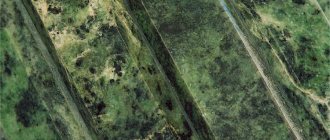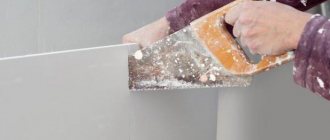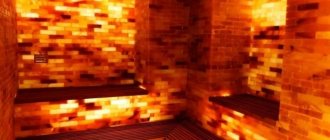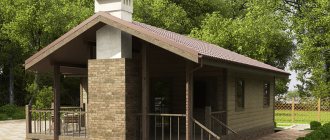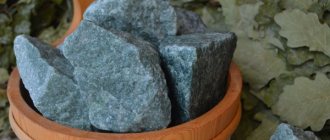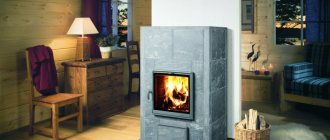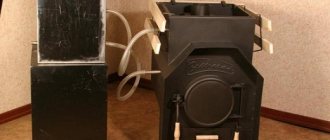A bathhouse is a place of rest and relaxation that has a long history. And the main condition is that the bathhouse is built with high quality and does not cause discomfort during operation. Just as a house begins with a door, so a bathhouse begins with the right stove. Let's consider how to choose a stove for a bath.
The majority of furnaces are similar to each other in design and operating principle. The main difference is their size, the presence of a water tank and design.
You may also be interested:
How to build a sauna yourself
How to build a bathhouse in the country
For example, stoves with a transparent door allow you to create a unique feeling of comfort and warmth. If you need a sauna not only for steaming, but it is also used as a means of heating water, then when deciding which stove to choose for a sauna, you should focus your choice on stoves with built-in water tanks.
How to choose stones for a bath or sauna?
At first glance, it may seem that selecting stones for a bath is a simple matter, however, there are some nuances here that not everyone knows about. First, you need to understand that bath stones each have their own physical characteristics, which you need to focus on when choosing.
- Density. Usually this refers to the weight of the stone. Experts recommend choosing bulkier stones.
- Heat resistance. It implies the ability of the stone to endure multiple cycles of heating and cooling, during which it will be able to retain its original properties;
- Heat capacity. It means the ability of a stone to accumulate and retain heat inside itself in order to subsequently release it into the environment. Stones with increased heat capacity are able to maintain the required temperature longer after the furnace heating process has stopped.
In addition to the specified characteristics, there are requirements that bath stones must meet:
- Environmental cleanliness;
- Homogeneous structure. You should not take cobblestones for a bath that have inclusions on the surface. Otherwise, you will not be able to provide uniform heating, and then they will begin to delaminate and collapse;
- No cracks. You can determine whether the stones have this defect in the following way: try knocking them against each other, or take a hammer and hit the stones with it. If you hear a clear sound, then there is no risk of cracks.
- Sizes and shape. Bath stones should be the same. Then they will be able to warm up evenly, which will allow the hot healing steam to penetrate into all areas of the steam room. Before looking at the structure of the stones, you must sort them according to their external characteristics: specimens with a smooth surface, oval or round shape are best suited.
But, according to some bathhouse attendants, such pebbles are more suitable for warming up a steam room, because they have a larger area of heat reflection, so the effect from them will be stronger. We cannot but agree with this, but we must remember that smooth stones are more resistant to cracks, so they will last longer.
If, during the selection process, you test the stones for density using a hammer, you can learn a lot about the quality characteristics of the samples being studied.
You can determine how well bath stones will cope with sudden temperature fluctuations using the following simple procedure: first you need to heat the cobblestone to the highest possible temperature, and then quickly transfer it to a bucket of cold water. After this, carefully inspect it from all sides - if you find no cracks, then this means that you have a high-quality stone that will last a long time.
Collect or buy?
Most often, bathhouse owners try to independently resolve the issue of stones for a sauna stove by looking for them along river banks and on mountain slopes. But if there is such an opportunity, then it is best to collect cobblestones for the heater near fresh water bodies, which are more preferable than sea pebbles due to the latter’s lower strength.
Typically, the following types of materials are used to heat a bath:
- jade;
- gabbro-diabase;
- soapstone, etc.
Their popularity is due to their impressive heat resistance and strength characteristics. At the same time, basalt, crimson quartzite, and white quartz are often used. Although they do not boast the same resistance to high temperatures, these stones have unique and beneficial properties for humans.
Even before you decide which stones you will use to heat the bath, you must decide on the place where you will look for them. If you are not very attracted to the option of searching for stones along river banks, then you can purchase them in specialized stores. By the way, you can find many worthy ones there, including porphyrite, dunite, etc.
Of course, this method is quite expensive , but this way you will quickly solve your problem. If you have a lot of time, then you can try to find suitable stones in nearby places. But you should know about the characteristics of different types so that the stones used for the heater are not only effective, but also safe. This is worth remembering for those owners who are going to look for stones on the railway embankment.
Given their physical characteristics, you can use these stones to heat your sauna. But you must remember that they are treated with chemicals , so such stones may retain an unpleasant aroma, which can harm you while the steam room is warming up. After all, the remains of harmful compounds can easily pass into the air.
Porphyrite for a bath: reviews
Of course, no one has conducted a sociological study on whether steamers are satisfied with porphyrite, but there is information, we collected it, and we can say that no one has any major complaints about this stone. It is often used for “budget” filling of a heater , because the price is slightly higher than the price of gabbro.
As for the reviews about the disadvantages of porphyrite for baths , there are reports of the unpleasant smell of Karelian stones (by the way, this also applies to gabbro and diabase), but the reason and ways to avoid such troubles are discussed above. Those who are unlucky testify to the disappearance of the problem after just a few runs.
It is difficult to generalize about the lifespan of any stone in a heater, but there are reviews about porphyrite that report real two or more years of its service with a small amount of material requiring replacement.
Many people fill only part of the heater with it, mixing (if possible) with jadeite, which is placed on top, which significantly improves the quality of steam. From porphyrite alone, the steam is not heavy , but not so pleasant either. However, it is necessary to have something to compare with.
In general, opinions about porphyrite boil down to the fact that the stone is suitable and inexpensive . A price comparison will help us prove the latter.
Characteristics of some types of stones for baths
Most often, natural stones that can be found near your place of residence are chosen to heat the heater. Their natural shape and size are the result of long-term exposure to natural factors - water, sun and wind.
If you decide to purchase stones for a heater in a store, for example, dunite, you can find artificial samples there that you can use in the steam room. But, unfortunately, you will not find in them what people most often want to go to the bathhouse for - the healing effect. Considering this, it is best to choose natural materials.
Unique properties of jadeite stone
This stone can be recognized by its characteristic greenish color. Jadeite is highly durable and represents a group of semi-precious rocks, which is why it has a fairly high cost. In more detail, its price is explained by the following advantages:
- Attractive appearance;
- High heat capacity;
- Low water absorption coefficient;
- Unique healing properties.
This stone is most suitable for use in a heater . Moreover, in order to save money, there is no need to buy a complete set at once. A few cobblestones are enough to lay on top of the masonry.
Man has long learned about the beneficial properties of jadeite. First of all, a beneficial effect on the human body in a warm state. This has a positive effect on the functioning of the circulatory, nervous, genitourinary and other systems.
Its therapeutic effect is also manifested on the joints. Jadeite is highly valued by bioenergeticists, who believe that the stone is capable of restoring the human energy field.
It should also be mentioned that jadeite is capable of producing:
- infrared radiation;
- air ions;
- metasilicic acid.
Jadeite demonstrates maximum effectiveness only in the first 5 years, and after that its healing power begins to weaken.
Regardless of whether you decide to use jadeite or any other stone for the steam room, remember that for a Russian bath it is advisable to use crushed samples. After all, they have a larger surface area, which means they can provide more steam. As for polished stones, they are most effective in the sauna.
Soapstone: king of saunas
A stone with a grayish tint is no less popular than jadeite. This is explained not only by its high strength , but also by its ability to heat up quickly and accumulate a lot of heat inside itself. The use of soapstone in the steam room is recommended by experts, as it allows you to get light and pleasant steam. If you are going to use not only soapstone, but also other stones for your heater, then keep in mind that it quickly becomes clogged with stone dust. Therefore, before placing stones on the stove, you will have to wash and harden them each time.
Soapstone is unique in that it is capable of generating soft, radiant heat , the waves of which have the same length as the heat generated by the human body.
first discovered in Finland and Karelia , which is why it is most often used for saunas in these countries. And this is not particularly hampered by its high cost.
Raspberry quartzite
When choosing stones for a stove in a bathhouse, you should not ignore crimson quartzite. With a vibrant purple-brown hue, this stone is highly durable and resistant to cracking. You can pour cold water on the hot cobblestones of crimson quartzite without fear of their destruction. It has high heat capacity and low water absorption coefficient.
Raspberry quartzite is popular not only due to its durability, but also for its healing properties:
- improves the functioning of the circulatory system, normalizes blood pressure;
- relieves pain in joints;
- very effective in treating migraines, as well as in cases of deterioration of health caused by changes in weather;
- improves the functioning of the reproductive system.
The main advantage of crimson quartzite is its ability to produce light steam for a long time even after the stove stops working. Therefore, if you want to enjoy the soft, beneficial and healing heat for as long as possible, then you should use this stone to warm up the bath.
Soapstone - a gift from Finland
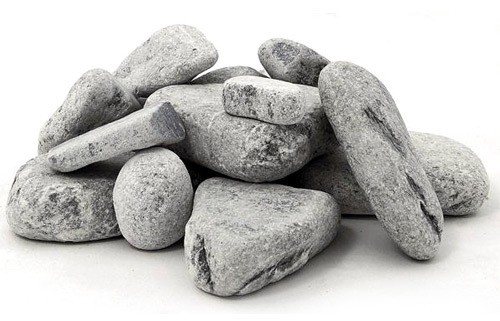
Soapstone chlorite for heater
A stone that can retain its original appearance even at temperatures above 1500 degrees. Soapstone is not very attractive in appearance, but it heats up quickly and gives off heat for a long time, has increased heat capacity and heat resistance. When heated, it does not emit harmful substances, but over time it may begin to generate dust.
Soapstone facing tiles and heaters
Before placing it in the heater, it is recommended to get rid of dust particles; to do this, you need to wash and calcine the stones.
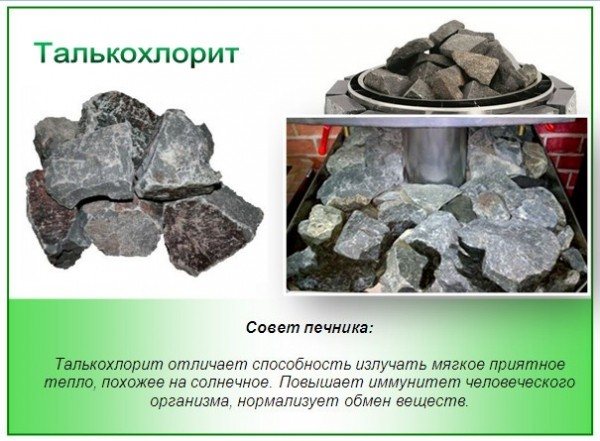
Bath stones – soapstone
The thermal radiation of the human body and this breed coincides, so the steam is perceived as more gentle and velvety. The mineral helps strengthen the human body’s immune system, resistance to infections, accelerates metabolism and has a beneficial effect on the respiratory tract.
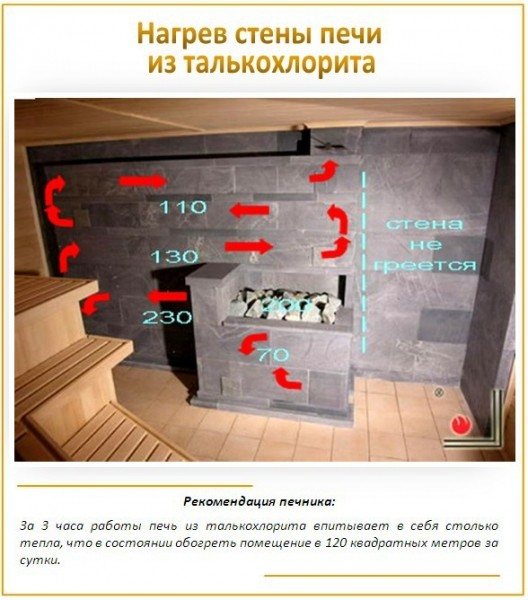
Soapstone stoves
Table. Soapstone - characteristics
| Characteristics | Indicators |
| Soapstone chlorite | Natural building and decorative material, rock of metamorphic origin, consisting of talc (40-50%), magnesite (40-50%) and chlorite (5-8%); mineral and chemical composition are variable. The stone is gray in color, opaque, depending on the impurities - white, brown, with a greenish or yellowish tint, and also (less often) red or dark cherry. Gloss - matte, silky. |
| Hardness | 1-5,5 |
| Density | 2,75 |
| Melting point | 1630—1640 °C |
| Specific heat | 0.98 kJ/kg°C |
| Thermal conductivity | 6 W/m°C |
| Thermal expansion | 0.001%/°C |
Prices for soapstone for baths
soapstone for baths
Other types of stone in the bathhouse
It is not at all necessary one of the types of stones discussed above for the heater Today there are many different rocks, among which you can certainly find the most suitable one for yourself, for example, porphyrite, dunite. Among them there are those that experts recommend for use:
- White quartz. A stone with a translucent surface that gives the heater a spectacular appearance thanks to its glow. This is precisely what explains its second name - “hot ice”. White quartz is ideal for open-type heaters because it is not incredibly durable and does not hold up well to elevated temperatures. And although it has a short service life, it is quite expensive;
- Gabbro-diabase. Ideal for heaters due to its high strength and heat storage capacity. In many ways it resembles soapstone, with the exception of one nuance - it costs much less, which is why it has become so widespread;
- Basalt. Bath stone is black in color, which, unlike other materials, has a very long service life. It manages to demonstrate this property due to its physical characteristics - high density, strength, low water absorption coefficient. In addition to this, it perfectly withstands frequent and sudden temperature changes, but primarily it is valued by owners because of its high heat capacity.
Reviews
I am very glad that we were finally able to get our hands on these magnificent stones.
Before this, we had to travel to different places and see different baths and heaters. But none of the previously used materials produced such vigorous, soft and strong steam. Jadeite amazed us. You feel so good that you want to continue to sit in the steam room and enjoy. Larisa
At one time, when I was faced with the choice of stones for a bath, I was advised to purchase gabbro-diabase.
As they explained to me, the material has a very dense structure and is able to withstand critical temperatures. I then decided to purchase a large batch - about 30 kg. But barely 6 months passed and I had to get rid of most of this breed. This vaunted gabbro-diabase turned into powder, ash and other loose substance. So I was convinced from personal experience that it is impossible to use this stone for a bath. At first we were very worried about the terrible smell, but we didn’t realize then that it was the smell of sulfur that was in the stone. After that, we decided to lay regular gray granite on the heater and had no more problems. Marina
A couple of days ago we bought some pebbles for our bathhouse.
We wanted to immediately take a large batch - more than 200 kg. Therefore, we bought 20 kg of jadeite, which, as we were told, is the best material for a sauna stove; it is mined in Siberia, and it costs more than others. We took the remaining 200 kg of crimson quartzite. As a result, his box cost us 350 rubles. We have a Harvia stove in our bathhouse. Just now they started drowning. I would like to think that they will not disappoint us. Victor
Raspberry quartzite - royal stone
Quartzite is capable of withstanding temperatures above 2500 degrees and is known for its high density and good heat capacity. Crimson quartzite was used by kings to decorate baths, hence the name.
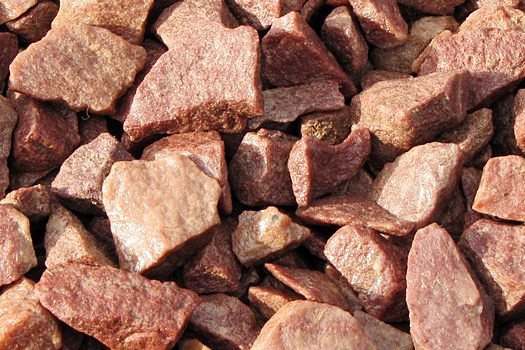
Crimson quartzite has a noble purple color
When choosing this breed, it is recommended to give preference to processed specimens. Otherwise, over time, the sharp edges will begin to crumble, clogging the passages.
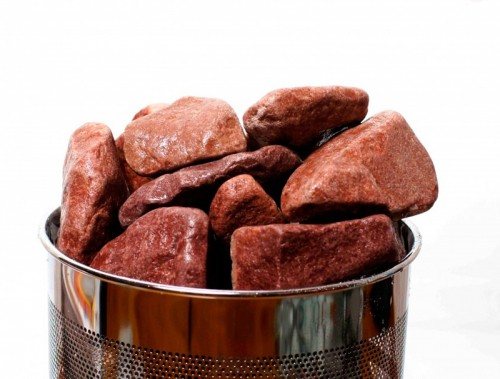
Raspberry Quartzite, embanked
This breed will decorate the bathhouse and have a beneficial effect on human health. People with low blood pressure, joint pain, heart problems, and hypertensive patients simply need to visit a quartz-filled bathhouse. For lovers of salty foods, such a session will also not hurt, because the stone helps with the deposition of salts.
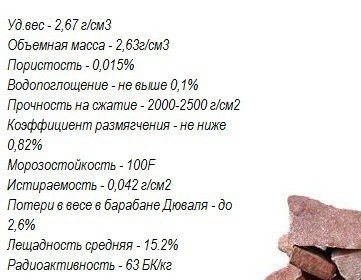
Characteristics of stone for baths and saunas – Crimson quartzite
Prices for crimson quartzite
crimson quartzite for a bath
